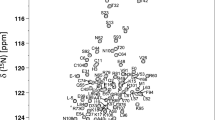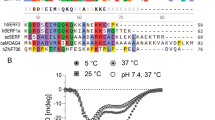Abstract
PTPN5 is a protein tyrosine phosphatase that plays an integral role in regulating excitatory postsynaptic activity. The sequence-specific backbone assignments of the murine PTPN5 catalytic domain have been determined based on triple-resonance experiments using uniformly [2H,13C,15N]-labeled protein.

Similar content being viewed by others
References
Alonso A, Sasin J, Bottini N, Friedberg I, Osterman A, Godzik A, Hunter T, Dixon J, Mustelin T (2004) Protein tyrosine phosphatases in the human genome. Cell 117(6):699–711
Braithwaite SP, Paul S, Nairn AC, Lombroso PJ (2006) Synaptic plasticity: one STEP at a time. Trends Neurosci 29(8):452–458
Chin J, Palop JJ, Puolivali J, Massaro C, Bien-Ly N, Gerstein H, Scearce-Levie K, Masliah E, Mucke L (2005) Fyn kinase induces synaptic and cognitive impairments in a transgenic mouse model of Alzheimer’s disease. J Neurosci 25(42):9694–9703
Eswaran J, von Kries JP, Marsden B, Longman E, Debreczeni JE, Ugochukwu E, Turnbull A, Lee WH, Knapp S, Barr AJ (2006) Crystal structures and inhibitor identification for PTPN5, PTPRR and PTPN7: a family of human MAPK-specific protein tyrosine phosphatases. Biochem J 395(3):483–491
Fraczkiewicz R, Braun W (1998) Exact and efficient analytical calculation of the accessible surface areas and their gradients for macromolecules. J Comp Chem 19(3):319–333
Goebel-Goody SM, Wilson-Wallis ED, Royston S, Tagliatela SM, Naegele JR, Lombroso PJ (2012) Genetic manipulation of STEP reverses behavioral abnormalities in a fragile X syndrome mouse model. Genes Brain Behav 11(5):586–600
Jeeves M, McClelland DM, Barr AJ, Overduin M (2008) Sequence-specific 1H, 13C and 15N backbone resonance assignments of the 34 kDa catalytic domain of human PTPN7. Biomol NMR Assign 2(2):101–103
Lombroso PJ, Naegele JR, Sharma E, Lerner M (1993) A protein tyrosine phosphatase expressed within dopaminoceptive neurons of the basal ganglia and related structures. J Neurosci 13(7):3064–3074
Meier S, Li YC, Koehn J, Vlattas I, Wareing J, Wennogle LP, Grzesiek S (2002) Backbone resonance assignment of the 298 amino acid catalytic domain of protein tyrosine phosphatase 1B (PTP1B). J Biomol NMR 24(2):165–166
Munoz JJ, Tárrega C, Blanco-Aparicio C, Pulido R (2003) Differential interaction of the tyrosine phosphatases PTP-SL, STEP and HePTP with the mitogen-activated protein kinases ERK1/2 and p38alpha is determined by a kinase specificity sequence and influenced by reducing agents. Biochem J 372(Pt 1):193–201
Mustelin T, Tautz L, Page R (2005) Structure of the hematopoietic tyrosine phosphatase (HePTP) catalytic domain: structure of a KIM phosphatase with phosphate bound at the active site. J Mol Biol 354(1):150–163
Nguyen TH, Liu J, Lombroso PJ (2002) Striatal enriched phosphatase 61 dephosphorylates Fyn at phosphotyrosine 420. J Biol Chem 277(27):24274–24279
Peti W, Page R (2007) Strategies to maximize heterologous protein expression in Escherichia coli with minimal cost. Protein Expr Purif 51(1):1–10
Saavedra A, Giralt A, Rue L, Xifro X, Xu J, Ortega Z, Lucas JJ, Lombroso PJ, Alberch J, Perez-Navarro E (2011) Striatal-enriched protein tyrosine phosphatase expression and activity in Huntington’s disease: a STEP in the resistance to excitotoxicity. J Neurosci 31(22):8150–8162
Wishart DS, Sykes BD (1994) The 13C chemical-shift index: a simple method for the identification of protein secondary structure using 13C chemical-shift data. J Biomol NMR 4(2):171–180
Acknowledgments
We thank Dr. Paul Lombroso, Yale University, for providing PTPN5 DNA. We thank Dr. Michael Clarkson for critical reading of the manuscript. This work was supported by an American Cancer Society Research Scholar Grant (RSG-08-067-01-LIB) to R.P. 800 MHz NMR data were recorded at Brandeis University. This spectrometer was funded by the National Institutes of Health grant S10-RR017269.
Author information
Authors and Affiliations
Corresponding authors
Rights and permissions
About this article
Cite this article
Francis, D.M., Page, R. & Peti, W. Sequence-specific backbone 1H, 13C and 15N assignments of the 34 kDa catalytic domain of PTPN5 (STEP). Biomol NMR Assign 8, 185–188 (2014). https://doi.org/10.1007/s12104-013-9480-8
Received:
Accepted:
Published:
Issue Date:
DOI: https://doi.org/10.1007/s12104-013-9480-8




